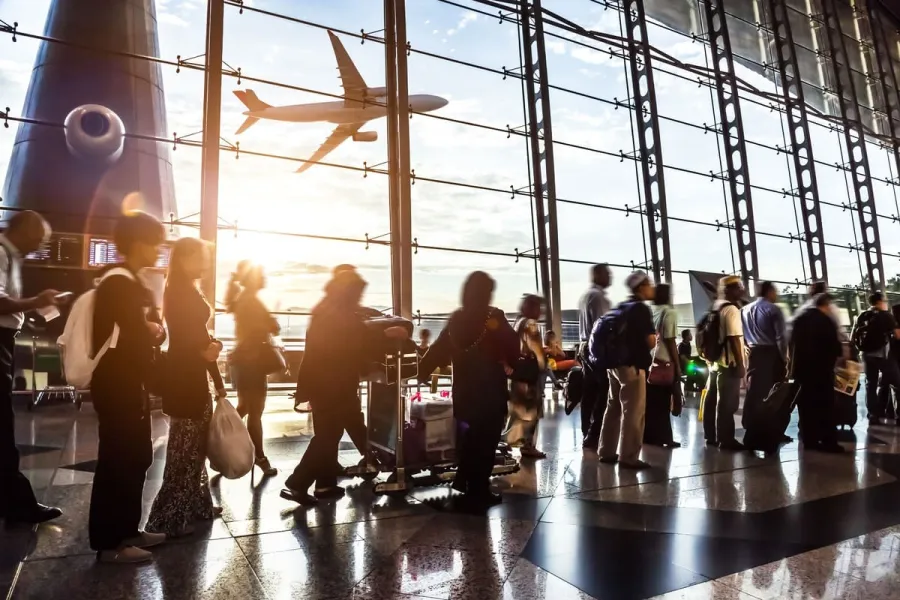Change language
Top 5 most dangerous airports in the world
May 23, 2025

When most people think about flying, they picture smooth landings, long runways, and wide-open skies. But at a handful of airports around the world, the reality is very different — and a lot more thrilling. Imagine planes threading through narrow mountain passes, landing on runways that seem barely long enough, or descending over beaches so close you can feel the jet blast.
These airports aren't just destinations; they're experiences in themselves, where pilot skill, nerve, and a bit of luck all come into play. In this article, we’ll take you through the top five most dangerous airports in the world — places where every landing feels like a small miracle, and every takeoff demands absolute precision. Buckle up — it’s going to be a wild ride.
What makes an airport dangerous?
There are several characteristics that make an airport dangerous:
1. Runway characteristics
Short runway: a jet needs a specific amount of runway to accelerate to takeoff speed or decelerate after landing. If the runway is short, the plane must take off and climb faster than normal. If anything goes wrong (like an engine failure), there's almost no margin for aborting. Landing must be precise: too fast or too long, and the plane might overshoot into rough terrain or the ocean.
Narrow runway: with little lateral room, small deviations during crosswind landings can cause wheels to slip off the surface. Pilots have to keep perfect centerline discipline, especially when winds are strong or gusty.
Sloped runway: uphill landings slow down planes faster — but require more engine thrust for takeoff. Downhill takeoffs/landings can be terrifying: brakes are less effective, and gravity pulls the plane forward.
Uneven or rough surfaces: small bumps or holes can damage landing gear or cause a plane to skid, especially in rain. A rough surface increases the risk of aquaplaning when wet — the tires lose contact with the ground.
2. Geography and surroundings
Mountains, cliffs, obstacles: planes need to perform steep descents or sharp turns to fit into the geography, increasing the pilot’s workload and limiting reaction time.
Oceans, forests, cities:
- water landings after an engine failure are survivable but extremely dangerous;
- dense urban areas increase the stakes for even small mistakes.
Limited escape routes: a normal airport allows "go-arounds" (abort the landing, climb, try again). In mountainous airports like Lukla, there’s no space to turn or climb again — once you're committed to land, there's no going back.
3. Altitude
High-altitude airports (above 2,000 meters) have:
- lower oxygen levels → Engines produce less thrust;
- lower air density → Wings generate less lift.
Planes must fly faster to create the same lift, meaning longer takeoff rolls and higher landing speeds — both very risky on short runways.
4. Weather conditions
Fog: pilots may not see the runway until seconds before touchdown.
Strong winds: crosswinds or sudden gusts can physically blow the plane off course during landing.
Wind shear: sudden shifts in wind speed/direction — can slam a plane into the ground or stall it mid-approach.
Snow and ice: reduces braking effectiveness, increases aquaplaning risk, and adds weight to the wings (dangerous for lift).
5. Pilot skill required
Some airports (like Paro or Courchevel) require pilots to have completed a number of supervised landings before they can fly solo into them. Automation (autopilot, auto-land) doesn't work well in these complex, terrain-heavy approaches. Pilots must hand-fly with near-perfect timing and control — something that even experienced pilots can find stressful.
6. Traffic volume
Busy airports with complicated approaches leave little room for delay or error. In poor weather, high traffic multiplies the chance of near-misses or runway incursions. Miscommunication between pilots and air traffic controllers becomes a bigger risk under pressure.
Additionally, delays are more likely at these challenging airports, and if your flight is delayed, you might be eligible for compensation for a delayed flight depending on the airline and local regulations (such as EU 261 in Europe).
7. Infrastructure limitations
Lack of ILS (Instrument Landing System):
- no precise vertical and lateral guidance — pilots must rely on visual cues or basic navigation aids.
In fog or storms, it's much harder to line up properly.
Outdated facilities:
- poor runway lighting, inadequate signage, and outdated radar can create confusing or dangerous situations, especially for foreign pilots unfamiliar with the airport.
Top 5 most dangerous airports in the world
Not all airports are built alike — some demand incredible precision, nerves of steel, and perfect weather to pull off a safe landing. Here are the top five airports where flying becomes a real adventure, and where every touchdown feels like a true achievement.
1. Lukla Airport (Tenzing-Hillary Airport) – Nepal
If you’re planning to trek to Everest Base Camp, flying into Lukla Airport will probably be one of the most unforgettable parts of your adventure — and not just because of the views. Known as the “world’s most dangerous airport,” Lukla offers a landing experience that feels more like an extreme sport than a regular flight. The runway is perched high in the Himalayas, only 527 meters long and tilted 12% uphill, designed to help planes brake quickly before they reach a sheer cliff drop. Pilots must rely entirely on visual flying — there’s no instrument landing system — and once they commit to land, there’s no chance for a go-around. It’s literally a one-shot deal.
Flights to Lukla are early in the morning to avoid the sudden fogs and fierce winds that roll in later in the day, often causing long delays. If your flight is delayed or canceled — which is very common — remember you may be entitled to compensation for a delayed flight depending on the airline’s policy. Many trekkers plan an extra day in Kathmandu for this reason. And here’s a tip: sit on the left side of the plane when flying into Lukla — the dramatic views of the Everest range unfolding beneath you will be absolutely breathtaking, offering a glimpse of the wild, stunning landscape you’re about to hike through.
Take a look to the biggest airports in the USA!
2. Courchevel Altiport – France
Flying into Courchevel Altiport in the French Alps isn’t just transportation — it’s an adventure in itself.
Located at an altitude of 2,008 meters (6,588 feet) in the heart of a luxury ski resort, this tiny airport is famous for its extremely short, steeply sloped runway — just 537 meters long and tilted at a jaw-dropping 18.5% incline. Pilots must land manually with no second chances: there’s no go-around procedure, no instrument landing systems, and minimal margin for error. It’s one of the few places in the world where, from touchdown to stop, the aircraft is practically climbing a hill. During the winter, snowy and icy conditions make landings even more thrilling — or terrifying — depending on your point of view.
Courchevel is popular among wealthy travelers and ski enthusiasts who want quick access to the slopes. If you book a flight into Courchevel, chances are you’ll be in a small plane or private jet, flown by pilots specially certified for alpine operations. Be prepared for delays or diversions if the weather turns bad — and always check if your travel insurance covers unexpected changes. For the best views, sit by a window and keep your camera ready: the final approach through the snowy mountains, with tiny chalets dotting the hills below, is like flying straight into a winter postcard.
3. Paro International Airport – Bhutan
Landing at Paro International Airport in Bhutan is not just rare — it’s a genuine badge of honor for any traveler. Tucked away in a deep valley at 2,235 meters (7,332 feet) altitude, Paro is considered one of the most challenging airports in the world. Only about a dozen pilots globally are certified to land here, and it’s easy to see why: planes must thread between towering 5,500-meter peaks, fly low over homes and monasteries, and execute a sharp manual turn just before lining up with the runway. No automated landing aids are used; it's all visual flying, pure pilot skill. Watching the lush green valleys and ancient temples rush past your window during the descent is nothing short of breathtaking — and just a little heart-pounding.
Because of the difficulty, flights only operate during daylight hours and in clear weather. Delays or cancellations are common, so if your flight is pushed back, ask the airline if you're eligible for compensation for a delayed flight — and don’t forget to check your rights regarding compensation for delayed or lost luggage, especially if your bags don’t make the journey with you.
Pro tip: choose a window seat on the left when landing for magical views of the Himalayas, including Bhutan’s most sacred landmarks like the Tiger’s Nest Monastery perched impossibly on a cliff. In Paro, the journey is truly part of the destination.
4. Toncontín International Airport – Honduras
Arriving at Toncontín International Airport in Tegucigalpa, Honduras, is a pulse-racing experience that travelers don’t soon forget. At just 1,005 meters (3,297 feet) above sea level, Toncontín might not sound extreme — but the real danger is in the geography. The airport is nestled in a bowl of mountains, forcing pilots to make a sharp, steep 45- to 90-degree turn moments before landing. Add in the short 1,863-meter runway, frequent rainstorms, and the crowded urban sprawl surrounding the airport, and you get one of the most technically demanding approaches in commercial aviation. You’ll literally feel the plane banking hard, almost like a roller coaster, before it straightens up just seconds before touchdown.
Because of the risky descent and limited escape routes, flights into Toncontín are often delayed during bad weather — and if your flight is late, remember that you may qualify for compensation for a delayed flight depending on the airline and local laws. Travelers recommend sitting on the right side of the plane for stunning views of Tegucigalpa’s colorful, hilly neighborhoods as you descend. And if you love aviation, Toncontín is one of the few airports where just watching a plane land safely feels like a small miracle.
5. Princess Juliana International Airport – Sint Maarten (Caribbean)
Flying into Princess Juliana International Airport is one of the most unforgettable travel experiences — and not because of danger in the air, but because of what happens just before you land. This Caribbean airport, located just 4 meters (13 feet) above sea level, sits right next to Maho Beach, where planes descend so low that beachgoers can almost reach up and touch the landing gear. Pilots need incredible precision here: the runway stretches only 2,300 meters (7,546 feet), just enough for large jets like Boeing 747s to land safely, especially when strong ocean winds make the approach even trickier. Watching massive planes roar overhead just a few meters above the sand is both thrilling and surreal — a true highlight for aviation fans and travelers alike.
Because Sint Maarten sits in the hurricane belt, weather disruptions like delays and cancellations are fairly common. If your flight gets delayed or canceled, make sure to check if you’re eligible for compensation for a delayed flight or cancelled flight compensation — many airlines are required to reimburse you under international passenger rights.
Pro tip: Choose a window seat on the right side of the plane when landing — you'll get an incredible view of the turquoise waters and the lively beach scene as you make your final approach. Just be ready for a few bumpy seconds before touchdown, especially if the trade winds are strong!
What you can do to stay safe in the most dangerous airports
Here are some recommendations for getting through these airports:
1. Choose the Right Airlines
Not all airlines are created equal — especially when it comes to tricky airports. Always book with carriers that have a strong local reputation and high safety standards.
In places like Nepal, go for airlines that specialize in mountain flying — companies like Tara Air or Yeti Airlines are used to dodging cliffs and dancing through valleys. Their pilots aren't just trained; they've flown those routes hundreds of times.
Quick tip: Before you book, check online for any safety ratings or traveler reviews specific to that airport.
2. Travel in Good Weather (If Possible)
Timing your flight can make a huge difference. Early morning flights are the golden ticket — air is calmer, visibility is better, and you avoid the daily weather drama that builds up later.
Try not to fly during monsoon seasons, hurricane windows, or heavy snow periods unless you really have to.
Pro move: Look up the local weather patterns for your destination a few months ahead. Booking a few days' flexibility into your plan can save you a ton of stress (and maybe even compensation for a delayed flight if the weather gets nasty).
3. Follow Crew Instructions Carefully
Sure, you’ve heard the safety talk a million times — but at tough airports, every second counts if something goes wrong. Fasten that seatbelt tight across your hips (not loose on your lap) and listen carefully to those "brace position" instructions.
Remember: during takeoff and landing (the "critical phases"), staying calm, buckled, and aware is your best protection.
Bonus: Count the number of rows between you and the nearest exit — in an emergency, you might have to find it by feel.
4. Pick a Safer Seat
Where you sit can actually improve your odds if something unexpected happens.
Seats over the wings are structurally stronger and statistically safer. Exit rows give you faster access out — just be sure you're physically ready to help open a door if needed.
Small hack: On short, intense landings (like Lukla or Courchevel), sitting near the front helps you disembark quicker, which can be a comfort if you’re a nervous flier.
Read more about how to choose the best seat on the plane!
5. Know Emergency Procedures
It’s not paranoid — it’s smart.
When you sit down, locate your nearest exits (remember: it might be behind you).
Actually read the safety card — it’s customized for that specific plane, and at complex airports, even a small difference (like how life vests are deployed) can matter.
Golden rule: In an emergency, most people freeze. If you already know what to do, you’ll move faster and safer.
6. Stay Calm and Alert
Turbulence, crosswinds, bumpy landings — they’re all normal at challenging airports.
It can feel scary, but panicking makes things worse — your reaction time slows down, and you might miss important crew instructions.
Stay mentally ready for a few bumps. Most pilots who land at risky airports are trained for "unstable approach" recoveries, meaning they know how to fix a weird landing if it happens.
Mind trick: Treat turbulence like a speed bump in a car — unpleasant, but not dangerous on its own.
7. Trust the Pilots
If you’re flying into a place like Paro, Lukla, or Courchevel, know this: your pilots are absolute pros.
They’ve undergone special certification programs, simulation tests, and real-world training flights before they’re even allowed to carry passengers into these tricky airports.
They know the mountains, the weather patterns, the tight turns — it’s basically second nature to them.
Perspective: To them, what looks terrifying to you is just another Tuesday at work.
While they might sound intimidating, remember: strict training, advanced aircraft technology, and careful planning make these flights much safer than they seem. So if you ever get the chance to land at one of these legendary airports, embrace the adventure — it's a travel story you'll be telling for years to come.
More travel blog recommendations

Gør dit forsinkede, aflyste eller overbookede fly til en kompensation på op til €600!
Kompensation for flyforsinkelse annulleret
Flyrefusion for et aflyst forsinket fly
Flykompensation
©2025 AirClaim.com - Alle rettigheder forbeholdt Air Claim SA - Bdul. Pipera 1/Vi Bl. HYPERION TOWERS Et. 3 SP. BIR. 3 Cod 077190, Voluntari, Ilfov, Rumænien

















